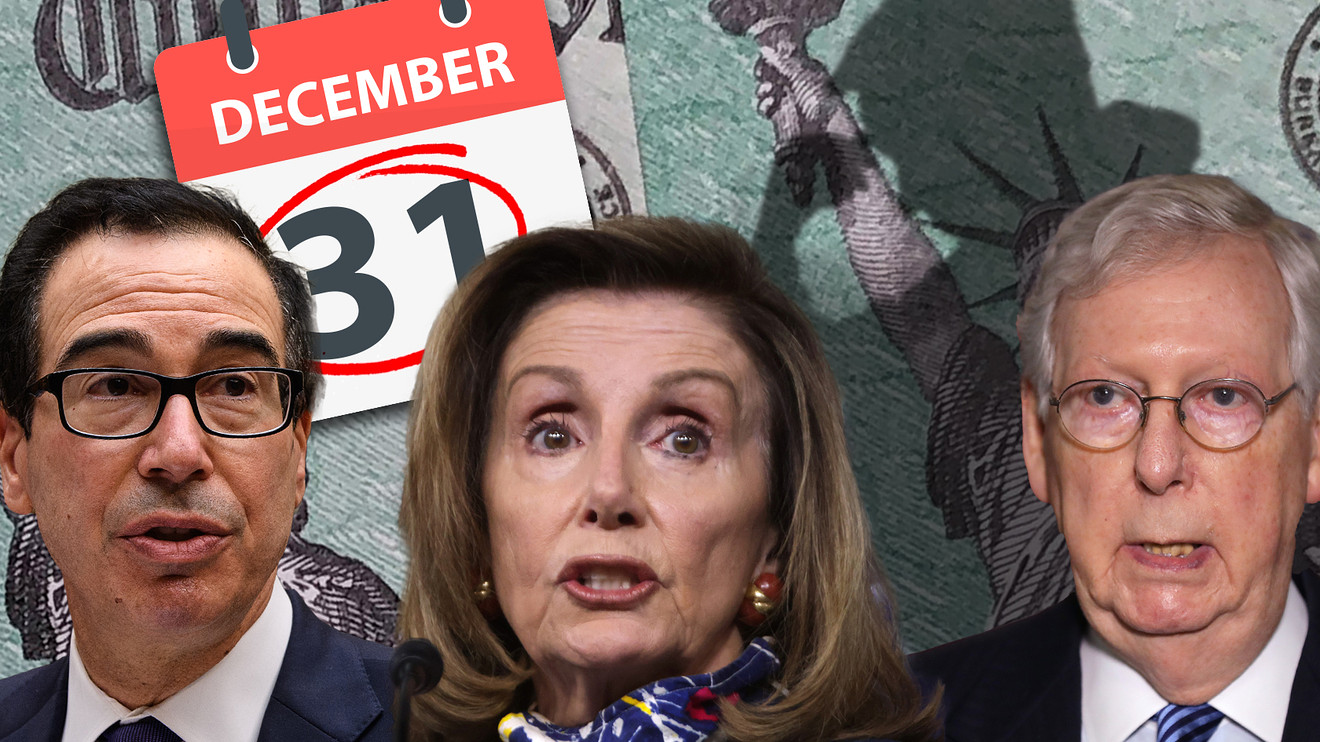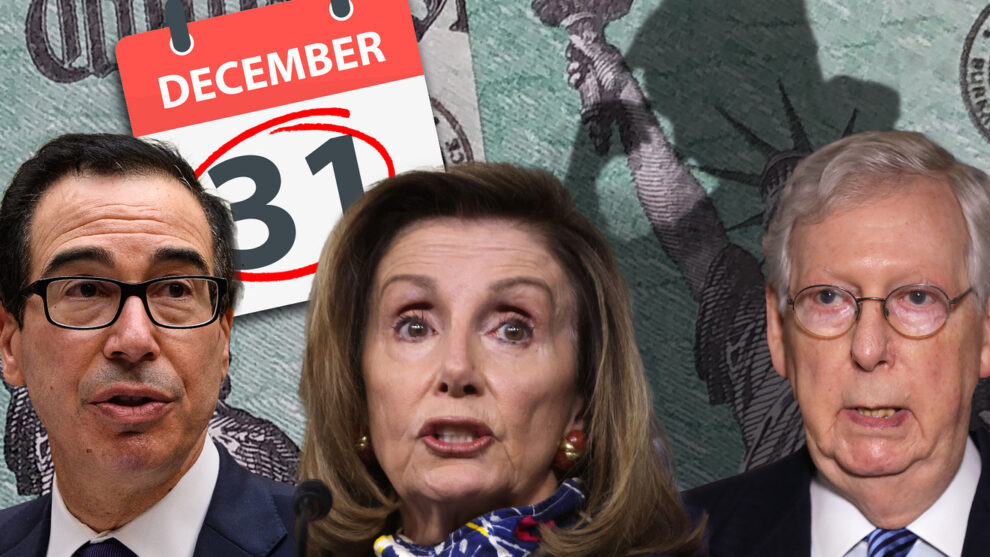
Lawmakers on Capitol Hill missed the window of time to ink a deal on another stimulus package before Election Day — but financially struggling Americans still have to face their own fast-approaching deadlines.
A wide range of financial assistance programs designed to help people stay in their homes, stay current on their student loans, keep their lights on and meet other financial obligations during the pandemic-induced economic downturn are scheduled to end on or before Dec. 31.
The Senate adjourned on Monday until Nov. 9., following its 52-48 vote to confirm Judge Amy Coney Barrett to the U.S. Supreme Court. Members of the House of Representatives are due back on Nov. 16. House Speaker Nancy Pelosi, Treasury Secretary Steven Mnuchin and Senate Republicans had been talking for three months on a follow-up bill to the $2.2 trillion CARES act passed in March.
When markets closed Monday, the Dow Jones Industrial Average DJIA, -0.59% was down 2.3%, the S&P 500 SPX, -1.21% ended down 1.9% and the Nasdaq Composite COMP, -2.45% ended down 1.6%. Stocks opened slightly higher on Tuesday morning.
“It is daunting to think about what the consequences will be for families, individuals, businesses, our economy when the COVID-19 protections and financial assistance are no longer available,” said Jack Gillis, executive director of the Consumer Federation of America, a research, service and advocacy organization promoting consumer interests.
See also: Desperate for a stimulus check, millions of jobless Americans have nearly exhausted their savings
A stimulus package — or at least some aspects — could conceivably pass in the lame duck session after Election Day and extend some of the deadlines. But the prospects of passage aren’t certain.
Here’s what’s sure for now: the looming expiration dates people are looking at when it comes to protections on past-due rent, unemployment benefits, utility bills, student loan payments and more.
Eviction moratoriums for renters
The U.S. Centers for Disease Control and Prevention issued a nationwide eviction moratorium in September. Health officials argued that people losing their homes could exacerbate the coronavirus pandemic, as displaced renters could be forced to move into more crowded living conditions with family or shelters.
Those protections only last through the end of the year. The CDC’s order ends on Dec. 31, meaning that starting in January of next year, landlords can resume evicting tenants.
The CDC recently clarified that landlords can take their tenants to court over missing rent payments in the meantime. In these cases, a judge could evict a tenant, but under the CDC order they would be allowed to remain in their home until the end of the year, at which point sheriff’s deputies could be ordered to escort them out.
The CDC’s eviction moratorium doesn’t offer blanket protection to all tenants. Renters have to notify their landlords proactively with a signed document to be covered by the order. And property owners have continued to evict tenants who did not take this step.
Renters who live in properties with federally-backed mortgages have additional protections if the property’s owner receives forbearance. The Federal Housing Finance Agency has barred landlords from evicting tenants for nonpayment of rent while in forbearance on Freddie Mac FMCC, -1.09% and Fannie Mae FNMA, -2.59% loans.
Both Fannie and Freddie have portals where renters can search to see if their property is covered by these protections. Here is Fannie Mae’s portal and this is Freddie Mac’s portal.
Some states and localities across the country have issued their own moratoriums on evictions since March. Under the CDC’s order, those moratoriums take precedence over the national one if they are more proactive. Many of these eviction bans have already expired, but in some states they will remain in place into next year.
California’s moratorium, for instance, lasts until the beginning of February, while New Jersey has prohibited evictions until two months after the state declares that its health emergency is over. Colorado recently enacted a 30-day eviction moratorium.
Mortgage forbearance and foreclosure moratoriums for homeowners
Under the $2.2 trillion CARES act passed in March, homeowners with federally-backed mortgages — which includes loans backed by Fannie Mae, Freddie Mac, the FHA, the Department of Veterans Affairs and the U.S. Department of Agriculture — can request up to a year’s worth of forbearance on their home loan.
The legislation required mortgage servicers to provide an initial forbearance period of 180 days, at the end of which borrowers could request an extension of 180 days. The bill did not require that borrowers show proof of financial hardship to qualify.
Because many homeowners initially requested forbearance back in the spring, their initial forbearance periods will end soon. If they still cannot afford to make their monthly payments, they need to request an extension from their loan servicer. Otherwise, the servicer will move to set up a repayment plan.
Homeowners should know they aren’t expected or required to make all of their missed payments at once. They can work with their servicer to set a suitable repayment plan, which could include an adjusted interest rate or longer loan term.
In August, the Federal Housing Finance Agency and the Federal Housing Administration both extended their moratoriums on foreclosures until the end of the year. These protections apply to any homeowners with federally-backed mortgages.
Under these orders, mortgage servicers are barred from pursuing new foreclosure actions against homeowners and evicting households. homeowners whose mortgages aren’t backed by the federal government can be foreclosed on or evicted.
It is not yet clear whether the federal agencies will extend these moratoriums into 2021; however both agencies have extended their bans on foreclosures multiple times.
Unemployment benefits for gig workers, independent contractors and other nontraditional workers
Before the CARES Act, self-employed workers, freelancers, gig workers and independent contractors were all ineligible for unemployment benefits. With the CARES Act, however, these workers became eligible for the $600 a week in federal unemployment benefits, which expired in July. They were also eligible for state unemployment benefits that were calculated based on the average weekly unemployment benefits in their state.
These state-level benefits, known as Pandemic Unemployment Assistance, expire Dec. 31. Come Jan. 1, more than 11 million Americans, including wedding photographers, Airbnb hosts and Uber UBER, -1.90% and Lyft LYFT, -0.43% drivers, will see their benefits reduced to zero.
“It’s a grim cut off for those counting on Pandemic Unemployment Assistance,” said Andrew Stettner, a senior fellow at the liberal-leaning Century Foundation.
The only way many of these Americans could still qualify for unemployment benefits is if they “have a history of W2 work,” Stettner said, meaning that they worked a “traditional” job where their employer reported their earnings to the government. That is also the main way of proving that you qualify for unemployment benefits.
There is an appetite on Capitol Hill for making sure these types of workers continue to receive some form of unemployment benefits, said Michele Evermore, a senior policy analyst at the National Employment Law Project, an advocacy organization focused on workers’ rights. “But financing it would be tricky,” she added.
Paid time off for employees coping with coronavirus and child care issues
A federal law enabling paid sick leave and expanded family and medical leave is expiring at the end of the year.
The Families First Coronavirus Response Act applies to people who have to stay away from their job because they have to quarantine. The law also applies to workers who need to stay home to take care of a loved one, like a child who’s suddenly stuck at home because of a school closure.
Pay amounts depend on whether the leave has to do with medical reasons or family care. For example, someone who is taking sick leave can receive up to $511 daily and $5,110 in total, according to the Department of Labor. A worker can also receive up to $2,000 in a two-week period for child care under one part of the law, and an additional $10,000 for another 10 weeks of leave under another part of the law. Small businesses with fewer than 50 employees can apply for exemption from the law if they can say granting leave will jeopardize business operations.
A range of state and local laws might also kick in for workers looking for paid time off, but experts note coverage under those statutes are not a given.
Protections against having utilities disconnected
At one point, 35 states implemented moratoriums blocking utilities from shutting down gas, water and electricity for non-payment. As of late October, 17 states and Washington D.C. still have moratoriums in force — but 13 of those moratoriums will expire at or before December 31.
Though many moratoriums are coming to a close, experts say cash-strapped consumers still have ways to avoid shut-downs. One way is apply for financial assistance to defray utility bills through the federally-funded Low Income Home Energy Assistance Program. Another way is to call the utility directly to see what sort of payment plan or deferral can be arranged.
“In general terms, if someone is in arrears or facing a shutoff, the first step is try to work out a payment plan with the utility,” Gillis said. “Paying something shows good faith. In the case of service provided by an [investor-owned utility], it could be useful to call and see what the state public utilities commission or public service commission has to say.”
Payment pauses on student loans
President Donald Trump extended the pause on payments and collections for some federal student loans through Dec. 31.
The pause, which was part of the CARES Act, was originally set to expire on Sept. 31, roughly one month before the presidential election. Advocates have worried the extension won’t be enough to provide borrowers with meaningful relief.
As of September, the economy had only recovered about 11.4 million of the 23 million jobs shed during the pandemic. Without a significant uptick in employment, it’s unlikely that borrowers will be in a much better position to repay their student loans in January than they were in October, advocates say.
That’s in part why many are urging policymakers to consider some form of student debt cancellation as part of a coronavirus relief package. Democratic presidential candidate Joe Biden has said that if he’s elected, he would immediately cancel $10,000 in student loans for borrowers. Congressional Democrats have gone even further; Senators Elizabeth Warren and Chuck Schumer have urged the next president to immediately cancel up to $50,000 in student debt.
Advocates have also urged for any coronavirus relief package to include more borrowers. Right now, at least $165 billion in federal student loans are excluded from the payment and collections pause, according to Mark Kantrowitz, the publisher of Savingforcollege.com.
They’re also warning of a wave of administrative and financial headaches once student loan payments resume. Borrowers have been victim to a host of errors during the payment and collections pause, including, in some cases, continuing to have their wages garnished during the pandemic and experiencing a ding on their credit score.
A break on payroll taxes
With stimulus talks at a stalemate in late summer, Trump signed an executive order allowing employers to temporarily stop deducting 6.2% from an employee’s paycheck for Social Security taxes. The deferral is in place from Sept. 1 to Dec. 31 and it applies to people making under $104,000 annually.
It’s up to employers to decide whether to arrange a deferral for their employees. But one expert noted that if a paycheck is larger now because it’s forgoing the tax, it’s going to be smaller starting next year. That’s because the worker’s 6.2% tax obligation will be back in effect — and they will also be paying the deferred taxes from September through December.
Favorable terms for 401(k) withdrawals
The tax code typically discourages people who tap their 401(k) plans early, assessing a 10% penalty on the withdrawals of anyone who’s under age 59 and one-half. But the CARES act put aside the early withdrawal penalty through Dec. 31. The same law allowed people facing hardship from the pandemic to withdraw up to $100,000 this year from their IRA or 401(k); if they pay back the amount in three years, the account holders can avoid paying income taxes on the retirement money they tapped this year.
Experts caution the interim tax consequences can be complicated, but those twists may be a small price for people who need the money now.
This story was updated on Oct. 27, 2020.






